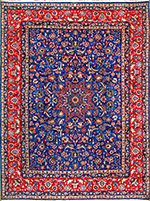Textiles Studies

Textile Research Works
Date of this Version
1993
Document Type
Article
Citation
Exhibition, The Textile Museum, October 15, 1993 - May 1, 1994.
Abstract
The Safavid period in Iran was a golden age for textile arts. It was in the 16th century that the Classical Persian carpet evolved to its fully developed form, and it was then that woven silks and velvets reached the highest technical and aesthetic standards of all time. In subsequent periods of Persian history, textiles and carpets reflect the extraordinary achievements of the Safavid era which have never been surpassed.
Under the reign of Shah Abbas I, who reigned from 1588 to 1629, Iran established important economic ties not only with the rapidly emerging European powers, but with the Mughal empire in India as well. In a flourish of diplomatic and commercial activity, textiles figured prominently and silk was the major item of export. Persia's engagements with the West in the Safavid period contributed dramatically to the presence of Persian carpets and textiles in European and American collections today.
Among the most important survivors of the diplomatic and commercial efforts of the Persian court in the 17th century is a group of extraordinary Safavid velvets today in the collections of Rosenborg Palace, Copenhagen. Recent research has confirmed that these velvets were probably the gift of Shah Safi, successor to Shah Abbas, to Duke Friedrich III, presented by a Persian embassy in 1639 to his court in SchleswigHolstein. Four textiles of this group have traveled across the Atlantic for the first time to be exhibited at The Textile Museum along with other 17thcentury Persian textiles and carpets drawn from our own rich collections.
Included in
Art and Materials Conservation Commons, Art Practice Commons, Fiber, Textile, and Weaving Arts Commons, Indigenous Studies Commons, Museum Studies Commons


Comments
© The Textile Museum, 1993